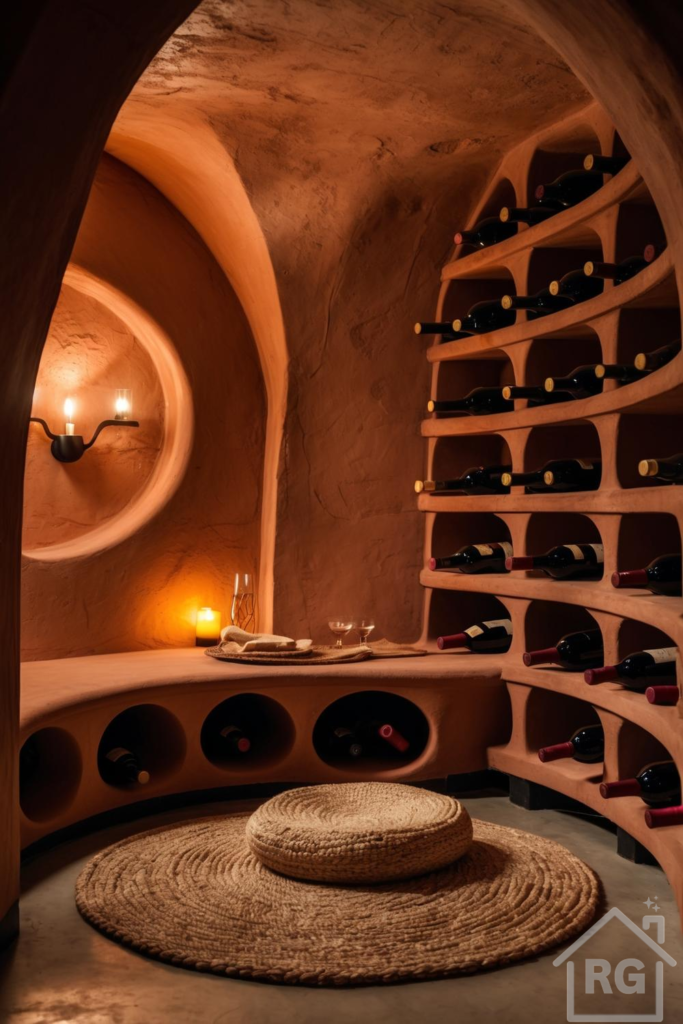
Embrace the Earth: Designing a Soulful Terracotta Wine Sanctuary
Imagine stepping into a space that feels both ancient and intimately modern – a personal haven carved from the very essence of the earth. The design we’re exploring isn’t just a wine cellar; it’s a testament to the profound beauty of organic design, a warm embrace of terracotta hues, and the quiet allure of rustic simplicity.
This is a room that invites you to slow down, to savor, and to connect with a deeper sense of tranquility. If you’ve ever dreamt of a wine storage solution that transcends mere functionality to become an experiential retreat, this guide will explore how to capture the spirit of this captivating design.
Key Elements of this Earthy Haven
To recreate or draw inspiration from this unique wine cellar, let’s break down its core components:
1. The Embrace of Terracotta: Walls, Shelves, and Warmth
The undeniable star of this room is the pervasive use of a warm, earthy material resembling terracotta or clay. It clads the walls in sweeping curves and forms the very structure of the integrated wine shelving. This isn’t just a color choice; it’s a textural statement. The material possesses a matte, slightly uneven finish that speaks of handcrafted artistry and natural origins.
- Color Psychology: Shades of terracotta, sienna, and burnt orange evoke feelings of warmth, comfort, security, and a connection to the earth. It’s a grounding palette that feels inherently welcoming.
- Achieving the Look:
- Textured Paints: Many paint brands offer terracotta hues. Opt for matte or suede finishes to mimic the look. You can also find paints with added texture.
- Plaster or Limewash: For a truly authentic and breathable finish, consider natural plasters like Tadelakt (though it requires skill) or a simpler pigmented clay plaster. Limewash offers a beautiful, chalky depth of color that ages gracefully.
- Faux Finishes: Skilled artisans can create faux terracotta effects using various painting techniques, layering colors and textures to achieve depth.
2. Organic Architecture: The Allure of Curves and Caves
This cellar eschews sharp angles for soft, flowing lines. The arched entrance, the curved walls, and the rounded niches for wine bottles create a cocoon-like, almost subterranean feel. It’s reminiscent of ancient dwellings or natural cave formations, fostering a sense of intimacy and protection.
- Design Impact: Curves soften a space and encourage a more relaxed, organic flow. They can make a room feel more expansive and less rigid.
- Implementation: Creating true curved walls is a significant construction undertaking. However, you can suggest curves through arched doorways, rounded furniture, or even by painting arched shapes or using curved shelving units against a flat wall.
3. The Soul of Natural Textures: Jute and Woven Elements
Grounding the earthy tones of the walls and shelving is a substantial, round jute rug and a matching jute pouf. These elements introduce a crucial textural contrast – the roughness of the woven fibers against the smoother (though still textured) clay-like surfaces.
- Tactile Appeal: Natural fibers like jute, sisal, or seagrass add warmth, texture, and a casual, rustic charm. They are durable and connect the space further to natural elements.
- Sourcing: Round jute rugs are widely available in various sizes. Look for poufs or ottomans made from similar materials or covered in natural linen or cotton canvas in earthy tones.
4. Illuminating the Mood: The Art of Soft, Warm Lighting
Lighting is paramount in creating the ambiance of this cellar. A strategically placed wall sconce with exposed, warm-toned bulbs casts a gentle glow, highlighting the curves of the wall. A flickering candle adds another layer of intimate, dynamic light.
- Key Principles: Avoid harsh, direct overhead lighting. Instead, focus on layered lighting: ambient (overall soft light), task (for specific activities, though minimal here), and accent (to highlight features).
- Fixtures:
- Sconces: Look for wrought iron, dark bronze, or antique brass sconces. Edison-style bulbs or warm LED equivalents enhance the rustic feel.
- Candles: Real candles offer unparalleled ambiance, but for safety and convenience, high-quality LED candles can be very effective. Group them in lanterns or on simple trays.
- Dimmer Switches: Install dimmers on all electric lights to allow for precise mood control.
5. Wine as Decor: Integrated and Celebrated Storage
The wine bottles themselves are not hidden away but are an integral part of the design. The built-in, arched niches display the collection beautifully, turning storage into an art form. This approach celebrates the purpose of the room openly.
- Aesthetic & Functional: The individual cubbies keep bottles secure and properly oriented while creating a visually appealing pattern.
- Achieving Similar Storage:
- Custom Built-ins: The ideal, but most expensive, option.
- Modular Racks: Many companies offer modular wine racks in wood or metal that can be configured to fit your space. Consider painting wooden racks to match your wall color for a more integrated look.
- DIY Shelving: For the handy, creating simple box shelves or using terracotta flue liners (if structurally sound and safe) could be creative alternatives.
Core Design Principles to Emulate
Beyond the specific elements, certain design principles contribute to this room’s success:
- Monochromatic Warmth: The design relies heavily on variations of a single color family (terracotta, brown, beige), creating a cohesive and immersive environment. Depth is achieved through texture and subtle shifts in tone rather than contrasting colors.
- Texture Layering: The interplay of smooth clay, rough jute, and cool glass (bottles, glasses) engages the senses and adds richness to the relatively simple color scheme.
- Embracing Imperfection (Wabi-Sabi): The natural materials and handcrafted feel suggest an appreciation for the beauty in imperfection, a core tenet of wabi-sabi philosophy. This isn’t a slick, overly polished space; its charm lies in its organic authenticity.
- Creating Intimacy: The enclosed, cave-like design, combined with warm lighting and soft textures, fosters a profound sense of intimacy and escape.
Bringing the Earthy Wine Cellar Vibe to Your Home: A Practical Guide
You don’t need a dedicated underground cellar to capture the essence of this style. Here’s how to adapt these ideas for your own space:
1. Walls and Surfaces: The Foundation of Earthiness
If you can’t build curved clay walls, focus on color and texture. Paint a feature wall, a nook, or a small room in a rich terracotta, sienna, or ochre. Use a matte or flat finish. For added depth, explore limewash or textured paints. Even a high-quality wallpaper with a subtle plaster or stone effect can work.
2. Flooring: Grounding the Space
The inspiration image features a dark, smooth floor, likely polished concrete, which provides a cool contrast to the warm walls. Other options include:
- Natural Stone Tiles: Slate, travertine, or darker limestone.
- Concrete-Look Tiles: Porcelain tiles that mimic concrete are durable and easier to maintain.
- Dark Wood: While not shown, a very dark, matte-finish wood floor could also complement the scheme, adding another layer of natural material.
3. Furnishings: Natural Comfort
Introduce natural fiber rugs (jute, sisal) in round or organic shapes. Add low poufs, floor cushions, or a simple wooden stool. Keep furniture minimal to maintain the uncluttered, serene feel. If you have a small table, choose one with a rustic wood or stone top.
4. Lighting: Crafting the Glow
Prioritize warm, indirect lighting. Use wall sconces with vintage-style bulbs. Incorporate table lamps with textured shades or floor lamps that cast an upward glow. Candles (real or LED) are a must for that intimate, flickering light. Always aim for a color temperature around 2700K (warm white) to enhance the cozy atmosphere.
5. Wine Storage (If Applicable): Display with Pride
If you’re incorporating wine storage, choose racks that complement the rustic aesthetic. Wrought iron, dark wood, or even terracotta wine racks can work. Think about how the bottles themselves contribute to the visual appeal, becoming part of the decor.
6. Accessories: Less is More
Accessorize sparingly. A few well-chosen items are more impactful than clutter in this minimalist-inspired rustic space:
- Simple Glassware: Clear or subtly tinted wine glasses.
- Rustic Tray: A wooden or slate tray for serving.
- Pottery: A single, beautiful piece of handmade pottery in an earthy tone.
- Linens: If you use any fabric, choose natural linen or textured cotton in neutral or warm earth tones.
The Sensory Experience: Beyond Visuals
This design appeals to more than just sight. Consider how to engage the other senses to fully capture the ambiance:
- Touch: The coolness of clay, the roughness of jute, the smoothness of glass.
- Scent: The subtle aroma of wine, the earthy scent of natural materials, perhaps a hint of beeswax from candles.
- Sound: The quiet, muffled acoustics of an enclosed space, promoting tranquility.
A Sanctuary for Savoring
Creating a space inspired by this terracotta wine cellar is about more than just aesthetics; it’s about crafting an environment that nurtures the soul. It’s a retreat from the everyday, a place to unwind, reflect, and enjoy the simple pleasure of a good glass of wine in a setting that feels both timeless and deeply personal.
Whether you dedicate an entire room or a cozy corner, embracing these principles of organic design, warm earth tones, and natural textures can help you cultivate your own unique sanctuary. Let the spirit of the earth guide your design, and you’ll create a space that truly resonates.
